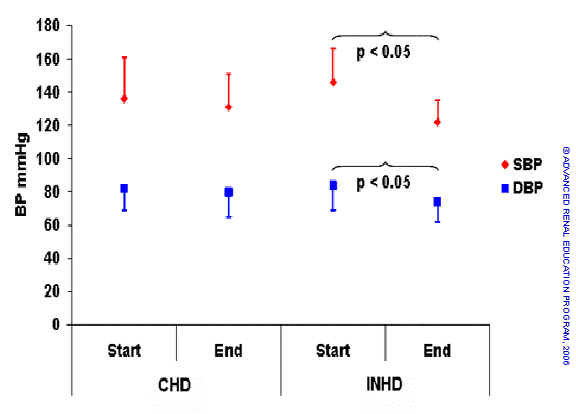Volume and Blood Pressure Control
All studies that have specifically addressed issues of volume and hypertension management report improvement. A good example is that where Fagugli et al. reported the results of a cross-over in 12 stable maintenance dialysis patients (1). Volume was assessed by bioimpedance, blood pressure by 24-hour ambulatory measurements and cardiac dimensions by echocardiography.
Extracellular volume as percent body weight (top); 24-hour daytime and nighttime systolic BP (middle) and LV dimensions (bottom) in patients converted from conventional to short daily HD (1)
Conventional HD comprised thrice-weekly sessions of approximately 4 hours; for sDHD, the same total weekly dialysis time was divided equally over 6 dialysis sessions. Each regimen was maintained for 6 months. Extracellular water expressed as percentage body weight decreased from 53% to 48% (p<0.02). Systolic and diastolic BP fell significantly (p<0.01). Fall in 24 hour SBP correlated with the decrease in ECV (r=0.63 p<0.01). Seven of 8 patients discontinued use of antihypertensive medications. The LV mass index decreased from 149 g/m2 to 120 g/m2 (p<0.01) and also correlated with reduction in ECV (r=0.66 p< 0.01). A trend for lower LV internal diameter was observed.
Chan et al. reported the effects on BP and LV mass in 28 patients treated by long nocturnal dialysis (lNHD) for a mean of 3.4 years compared to 13 patients using conventional HD at home for 2.8 years (2) .
BP (left) and left ventricular mass (right) responses to long nocturnal (lNHD) and conventional HD (CHD) (2)
Blood pressure fell significantly in patients treated with lNHD despite a reduction in antihypertensive agents (score 1.8 to 0.3). No change in BP or antihypertensives was found for CHD. Whereas LV mass index tended to rise in patients treated by CHD, there was a significant fall (p<0.05) in the patients treated with lNHD. Interestingly, no change in ECF volume was seen in the patients treated with lNHD.
From these data it appears that the two approaches to increased frequency – short daily and long nocturnal – are effective in improving BP management and reversing LV hypertrophy. In the London daily/nocturnal HD study it was possible to compare the effect of both treatment schedules within a single centre (3) . This study was a case controlled study comparing short daily (n=11) and long nocturnal (n=12) for a period of 18 months follow-up. Each case selected for increased frequency had a matched control treated by conventional HD. Both regimens of increased frequency HD were associated with significant lowering of mean arterial pressure (MAP) despite reduction in use of antihypertensives. No change in MAP for matched controls was found and the use of antihypertensives increased slightly. Volume and LV dimensions were not reported.
Why does blood pressure prove more manageable when dialysis frequency is increased (or when Tassin-style dialysis is performed)? The data from Fagugli (1) suggest that reduction in volume overload is a factor whereas no change in ECF volume was detected by Chan (2). In other publications, Chan and the Toronto group have identified a reduction in total peripheral vascular resistance and increased endothelium-dependent vasodilatation in response to treatment by long nocturnal dialysis. Identifying the mechanisms – volume related, hemodynamic related and/or some complex effect related to changed vasoreactive substances – will be important in determining the optimum increased frequency regime.
References:
-
Fagugli RM, Reboldi G, Quintaliani G, Pasini P, Ciao G, Cicconi B, Pasticci F, Kaufman JM, Buoncristiani U. Short daily hemodialysis: Blood pressure control and left ventricular mass reduction in hypertensive hemodialysis patients. Am J Kidney Dis 38:371-376, 2001
-
Chan CT, Floras JS, Miller JA, Richardson RM, Pierratos A. Regression of left ventricular hypertrophy after conversion to nocturnal hemodialysis. Kidney Int 61:2235-2239, 2002
-
Nesrallah G, Suri R, Moist L, Kortas C, Lindsay RM. Volume control and blood pressure management in patients undergoing quotidian hemodialysis. Am J Kidney Dis 42 (Suppl 1):s13-s17, 2003





